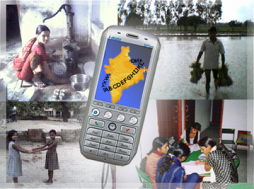When Matthew Kam first went to India, he noticed the lack of English literacy of children that had studied English for three or four years. Most couldn't read, didn't know simple words, and sometimes couldn't spell their own names. "We realized that those students who had taken English for three years couldn't read every letter in the alphabet," Matt said. "Teachers who were teaching English couldn't speak English themselves." However, the English literacy of these same children improved dramatically when presented with a unique learning tool: a mobile phone.
As part of his research for a computer science Ph.D., Matt is working with a team of researchers and students at the University of California at Berkley in the United States. The project, called MILLEE, or Mobile and Immersive Learning for Literacy in Emerging Economies, works to develop mobile phone games aimed at teaching literacy to children in India.
When the MILLEE team first started developing the games, Matt didn't envision them played on mobile phones. However, the more he learned about the the cultural and economic factors that impacted Indian schools, the more mobile technology seemed like the perfect fit. "A school for 200 kids might have two small buildings," said Matt. "There's no padlock door, so you couldn't put something valuable inside like a P.C. and lock it up. We also thought that desktop computers weren't working very well because they needed electricity. Mobile technology works anywhere and anytime for the kids to get access. And cell phone penetration is going up working in the developing world."
The group decided to design games in order to increase the interest of children in education. In rural areas of India children are often required to stay home to work in the fields, and families don't necessarily perceive the benefits of formal education. Additionally, some children just didn't like classroom instruction, often given by teachers who were underqualified in their field. "The kids weren't liking school, and they didn't come because they felt it was boring. So this was a good reason to do games for learning instead, to make education more compelling and engaging."
The team started designing the games by looking at already-available commercial language-learning software and at the approaches used in the most popular Western video games. However, after testing the games they found that many Indian children were confused by the conventions of Western video games. "We eventually watched how kids play traditional village games," he said, "and tried to understand how they were different from contemporary Western video games. We took all those lessons with us and designed special games."
At first, Matt was skeptical about how well the games would work on a mobile phone. "I think the biggest problem with a cell phone is it has a very small screen... And you have a very small keypad. There's limited information you can display," he said. However, in several pilot studies the games worked surprisingly well. In one study, students consistently showed better English skills on tests after playing the game. "We did not expect them to learn so fast," said Matt, noting that even some of the adults in the village wanted to use the mobile phone games. "It was interesting because some of their mothers would come and would say they wanted to enroll in the programs instead of their kids."
Matt and his research team are currently in the process of a longer term pilot, which began in December 2007 and will continue until the end of March. The pilot takes place in a village school in northern India, where students play the mobile games as part of an after-school program for two hours at a time, three days a week. Currently, the games only work on a Motorola Razr V3m phone. This is a clear drawback of the program. "From the engineering point of view, we didn't want to develop applications for low-end phones," said Matt. "We are hoping that in the next few years these phones will be much cheaper."
The funding for the MILLEE project has come from a variety of grants, including one from the US National Science Foundation and a Digital Media and Learning award from the MacArthur Foundation. Matt said that the project recently received a grant from Verizon to look at using mobile phones to teach English to Spanish-speaking immigrants in the United States.
Although the pilot studies have encountered some challenges -- they find that the phones can only teach basic English and not skills like creative writing, and many students have to be taught to use features like SMS -- Matt hopes to continue and expand the program in the future. "The next stage of my research is to look at how we can make literacy and mobile learning accessible to adult users," he said.
Photo courtesy of MILLEE.


Post new comment